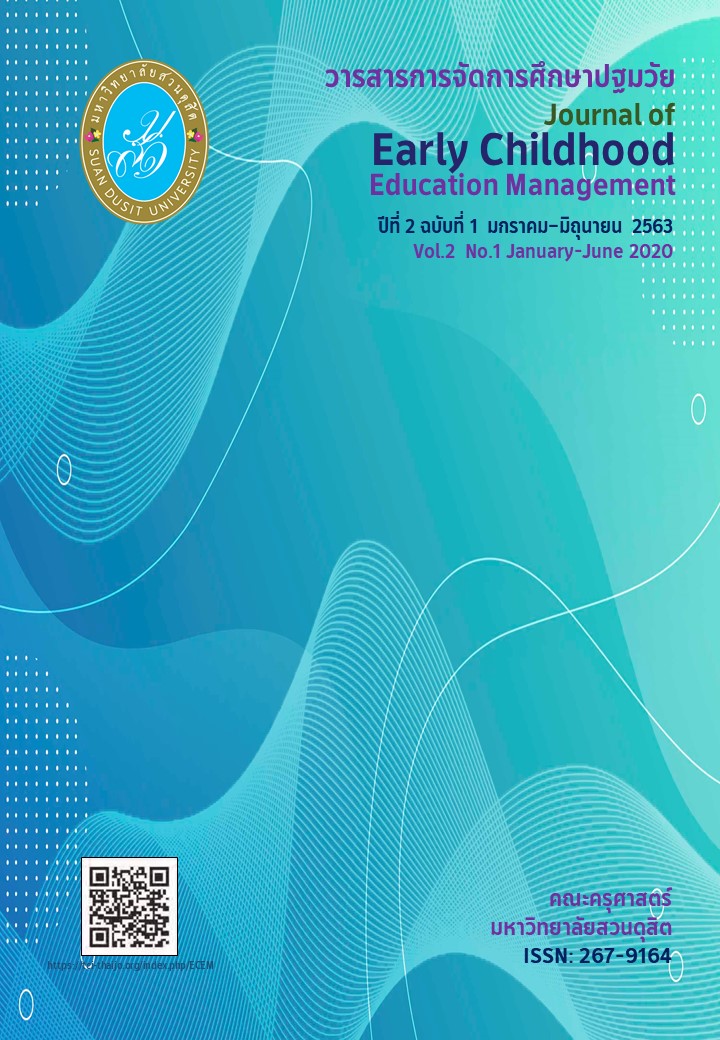ความพร้อมในการเข้าสู่ระบบการศึกษาของเด็กปฐมวัย (School Readiness)
บทคัดย่อ
บทความนี้มีเป้าหมายเพื่อทบทวนงานวิจัยที่บ่งชี้ถึงบทบาทและความสำคัญของความพร้อม
ในการเข้าสู่ระบบการศึกษาของเด็กปฐมวัย (School Readiness) ต่อผลสัมฤทธิ์ทางการศึกษาในระดับ ที่สูงขึ้นไป องค์ความรู้สำคัญที่ได้จากการทบทวนงานวิจัยดังกล่าวคือ ความพร้อมในการเข้าสู่ระบบการศึกษาของเด็กปฐมวัย ส่งผลบวกต่อผลสัมฤทธิ์ด้านคณิตศาสตร์และการอ่านในระดับประถมศึกษาหรือมัธยมศึกษาอย่างมีนัยสำคัญ หลักฐานส่วนนี้สะท้อนถึงความสำคัญของข้อมูลสถานะความพร้อมในการเข้าสู่ระบบการศึกษาของเด็กปฐมวัย ต่อการพัฒนาเด็กปฐมวัย และการพัฒนาทุนมนุษย์ในระยะยาว นอกจากนี้ บทความยังนำเสนอหลักการและรายละเอียดของชุดเครื่องมือสำรวจความพร้อมในการเข้าสู่ระบบการศึกษาของเด็กปฐมวัยที่ได้มาตรฐานระดับสากล
เอกสารอ้างอิง
Adolph, K. E. (2008). Learning to move. Current directions in psychological science, 17(3), p. 213-218.
Adolph, K. E. and Berger, S. E. (2007). Motor development. Handbook of child psychology, 2.
Andrew, A., Attanasio, O., Bernal, R., Sosa, L. C., Krutikova, S., and Rubio-Codina, M. (2019). Preschool quality and child development. Technical report, National Bureau of Economic Research.
Bennett, R. E., Gottesman, R. L., Rock, D. A., and Cerullo, F. (1993). Influence of behavior perceptions and gender on teachers’ judgments of students’ academic skill. Journal of Educational Psychology, 85(2), p. 347.
Bickel, D. D., Zigmond, N., and Strayhorn, J. (1991). Chronological age at entrance to first grade: Effects on elementary school success. Early Childhood Research Quarterly, 6(2), p. 105–117.
Blair, C. and Razza, R. P. (2007). Relating effortful control, executive function, and false belief understanding to emerging math and literacy ability in kindergarten. Child development, 78(2), p. 647-663.
Brookhart, S. M. (1993). Teachers’ grading practices: Meaning and values. Journal of Educational Measurement, 30(2), p. 123–142.
Brownell, M. D., Ekuma, O., Nickel, N. C., Chartier, M., Koseva, I., and Santos, R. G. (2016). A population-based analysis of factors that predict early language and cognitive development. Early Childhood Research Quarterly, 35, p. 6-18.
Carrow-Woolfolk, E. (1995). Oral and written language scales. Circle Pines, MN: American Guidance Service, 93(94), p. 947–964.
Chittleborough, C. R., Searle, A. K., Smithers, L. G., Brinkman, S., and Lynch, J. W. (2016). How well can poor child development be predicted from early life characteristics?: A whole-of-population data linkage study. Early Childhood Research Quarterly, 35, p. 19-30.
Davies, S., Janus, M., Duku, E., and Gaskin, A. (2016). Using the early development instrument to examine cognitive and non-cognitive school readiness and elementary student achievement. Early Childhood Research Quarterly, 35, p.63-75.
Diamond, A. (2000). Close interrelation of motor development and cognitive development and of the cerebellum and prefrontal cortex. Child development, 71(1), p. 44-56.
Duncan, G. J., Dowsett, C. J., Claessens, A., Magnuson, K., Huston, A. C., Klebanov, P., Pagani, L. S., Feinstein, L., Engel, M., Brooks-Gunn, J., et al. (2007). School readiness and later achievement. Developmental psychology, 43(6), p. 1428.
Dunn, L. M. and Dunn, L. M. (1997). PPVT-III: Peabody picture vocabulary test. American Guidance Service.
Engelhard Jr, G. (1994). Examining rater errors in the assessment of written composition a many-faceted rasch model. Journal of Educational Measurement, 31(2), p. 93-112.
Foster, E. M. (2010). The value of reanalysis and replication: Introduction to special section. Developmental Psychology, 46(5), p. 973.
Ginsburg, H. and Baroody, A. J. (2003). TEMA-3: Test of early mathematics ability. Pro-ed.
Goldfeld, S., O’Connor, E., O’Connor, M., Sayers, M., Moore, T., Kvalsvig, A., and Brinkman, S. (2016). The role of preschool in promoting children’s healthy development: Evidence from an australian population cohort. Early Childhood Research Quarterly, 35, p. 40-48.
Good, R. H. and Kaminski, R. A. (2002). Dynamic indicators of basic early literacy skills: DIBELS. Institute for the Development of Educational Achievement, Eugene, OR, 6th edition.
Grimm, K. J., Steele, J. S., Mashburn, A. J., Burchinal, M., and Pianta, R. C. (2010). Early behavioral associations of achievement trajectories. Developmental psychology, 46(5), p. 976.
Grissmer, D., Grimm, K. J., Aiyer, S. M., Murrah, W. M., and Steele, J. S. (2010). Fine motor skills and early comprehension of the world: two new school readiness indicators. Developmental psychology, 46(5), p. 1008.
Guhn, M., Gadermann, A. M., Almas, A., Schonert-Reichl, K. A., and Hertzman, C. (2016a). Associations of teacher-rated social, emotional, and cognitive development in kindergarten to self-reported wellbeing, peer relations, and academic test scores in middle childhood. Early Childhood Research Quarterly, 35, p. 76-84.
Guhn, M., Milbrath, C., and Hertzman, C. (2016b). Associations between child home language, gender, bilingualism and school readiness: A population-based study. Early Childhood Research Quarterly, 35, p. 95-110.
Guthridge, S., Li, L., Silburn, S., Li, S. Q., McKenzie, J., and Lynch, J. (2016). Early influences on developmental outcomes among children, at age 5, in australia’s northern territory. Early Childhood Research Quarterly, 35, p. 124-134.
Heckman, J. J. (2008): “The Case for Investing in Disadvantaged Young Children.” Mimeo University of Chicago.
Heckman, J. J., S. Moon, R. R. Pinto, P. A. Savelyev, and A. Q. Yavitz (2010). The rate of return to the Perry Preschool program. Journal of Public Economics.
Heckman, J., Pinto, R., and Savelyev, P. (2013). Understanding the mechanisms through which an influential early childhood program boosted adult outcomes. American Economic Review, 103(6), p. 2052–86.
Heckman, J. J., Humphries, J. E., and Kautz, T. (2014). The myth of achievement tests: The GED and the role of character in American life. University of Chicago Press.
Heroman, C., Burts, D., Berke, K.-l., and Bickart, T. (2010). Teaching strategies gold® objectives for development & learning: Birth through kindergarten.
High, P. C. et al. (2008). School readiness. Pediatrics, 121(4), e1008–e1015.
High/Scope Educational Research Foundation (2003). Preschool Child Observation Record. High/Scope Press, 2nd edition.
Hooper, S. R., Roberts, J., Sideris, J., Burchinal, M., and Zeisel, S. (2010). Longitudinal predictors of reading and math trajectories through middle school for african American versus caucasian students across two samples. Developmental Psychology, 46(5), p. 1018.
Ip, P., Rao, N., Bacon-Shone, J., Li, S. L., Ho, F. K.-w., Chow, C.-b., and Jiang, F. (2016). gradients in school readiness of chinese preschool children: The mediating role of family and kindergarten quality. Early Childhood Research Quarterly, 35, p. 111–123.
Janus, M. and Duku, E. (2007). The school entry gap: Socioeconomic, family, and health factors associated with children’s school readiness to learn. Early education and development, 18(3), p. 375-403.
Janus, M. and Offord, D. R. (2007). Development and psychometric properties of the early development instrument (edi): A measure of children’s school readiness. Canadian Journal of Behavioural Science/Revue canadienne des sciences du comportement, 39(1), p. 1.
McDermott, P. A., Fantuzzo, J. W., Waterman, C., Angelo, L. E., Warley, H. P., Gadsden, V. L., and Zhang, X. (2009). Measuring preschool cognitive growth while it’s still happening: The learning express. Journal of School Psychology, 47(5), p. 337-366.
McMillan, J. H., Myran, S., and Workman, D. (2002). Elementary teachers’ classroom assessment and grading practices. The journal of educational research, 95(4), p. 203-213
National Education Goals Panel (1991). The Goal 1 Technical Planning Subgroup Report on School Readiness. National Education Goals Panel, Washington, DC.
O’Connor, M., Gray, S., Tarasuik, J., O’Connor, E., Kvalsvig, A., Incledon, E., and Goldfeld, S. (2016). Preschool attendance trends in australia: Evidence from two sequential population cohorts. Early Childhood Research Quarterly, 35, p. 3139.
Pagani, L. S., Fitzpatrick, C., Archambault, I., and Janosz, M. (2010). School readiness and later achievement: a french canadian replication and extension. Developmental psychology, 46(5), p. 984.
Patel, S., Corter, C., Pelletier, J., and Bertrand, J. (2016). ‘dose-response’relations between participation in integrated early childhood services and children’s early development. Early Childhood Research Quarterly, 35, p. 49-62.
Pearce, A., Scalzi, D., Lynch, J., and Smithers, L. G. (2016). Do thin, overweight and obese children have poorer development than their healthy-weight peers at the start of school? findings from a south australian data linkage study. Early childhood research quarterly, 35, p. 85-94.
Raudenbush, S., Martinez, A., Bloom, H., Zhu, P., and Lin, F. (2008). An eight-step paradigm for studying the reliability of group-level measures. Report from the William T. Grant Foundation.
Raudenbush, S. W. and Sadoff, S. (2008). Statistical inference when classroom quality is measured with error. Journal of Research on Educational Effectiveness, 1(2), p. 138-154.
Romano, E., Babchishin, L., Pagani, L. S., and Kohen, D. (2010). School readiness and later achievement: replication and extension using a nationwide canadian survey. Developmental psychology, 46(5), p. 995.
Russo, J. M., Williford, A. P., Markowitz, A. J., Vitiello, V. E., and Bassok, D. (2019). Examining the validity of a widely-used school readiness assessment: Implications for teachers and early childhood programs. Early Childhood Research Quarterly, 48, p. 14-25.
Sabol, T. J. and Pianta, R. C. (2012). Patterns of school readiness forecast achievement and socioemotional development at the end of elementary school. Child development, 83(1), p. 282-299.
Schweinhart, L. J. and Weikart, D. P. (1997). The High/Scope preschool curriculum comparison study through age 23. Early childhood research quarterly, 12(2), p. 117-143.
Sedgwick, P. (2014). Relative risks versus odds ratios. Bmj, 348.
Shoda, Y., Mischel, W., and Peake, P. K. (1990). Predicting adolescent cognitive and selfregulatory competencies from preschool delay of gratification: Identifying diagnostic conditions. Developmental psychology, 26(6), p. 978.
Sutter, M., Untertrifaller, A., and Zoller, C. (2018). Busy little bees–an experiment on diligence and endogenous time scheduling in early childhood.
Taber, K. S. (2018). The use of cronbach’salpha when developingand reporting research instruments in science education. Research in Science Education, 48(6), p. 1273- 1296.
UNICEF (2012). School Readiness: A Conceptual Framework. United Nations Children’s Fund, New York.
UNICEF et al. (2017). Overview: MELQO: Measuring Early Learning Quality and Outcomes. UNESCO Publishing.
Waterman, C., McDermott, P. A., Fantuzzo, J. W., and Gadsden, V. L. (2012). The matter of assessor variance in early childhood education or whose score is it anyway? Early Childhood Research Quarterly, 27(1), p. 46-54.
Winsler, A., Hutchison, L. A., De Feyter, J. J., Manfra, L., Bleiker, C., Hartman, S. C., and Levitt, J. (2012). Child, family, and childcare predictors of delayed school entry and kindergarten retention among linguistically and ethnically diverse children. Developmental Psychology, 48(5), p. 1299.
Wolf, S., Halpin, P., Yoshikawa, H., Dowd, A. J., Pisani, L., and Borisova, I. (2017). Measuring school readiness globally: Assessing the construct validity and measurement invariance of the international development and early learning assessment (idela) in ethiopia. Early Childhood Research Quarterly, 41, p. 21-36
ดาวน์โหลด
เผยแพร่แล้ว
รูปแบบการอ้างอิง
ฉบับ
ประเภทบทความ
สัญญาอนุญาต
ลิขสิทธิ์ต้นฉบับที่ได้รับการตีพิมพ์ในวารสารการจัดการทางการศึกษาปฐมวัย ถือเป็นกรรมสิทธิ์ของคณะครุศาสตร์ มหาวิทยาลัยสวนดุสิต ห้ามผู้ใดนำข้อความทั้งหมดหรือบางส่วนไปพิมพ์ซ้ำ เว้นแต่จะได้รับอนุญาตอย่างเป็นลายลักษณ์อักษรจากคณะครุศาสตร์ มหาวิทยาลัยสวนดุสิต นอกจากนี้ เนื้อหาที่ปรากฎในบทความเป็นความรับผิดชอบของผู้เขียน ทั้งนี้ไม่รวมความผิดพลาดอันเกิดจากเทคนิคการพิมพ์




